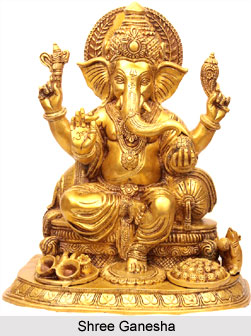 The Ganesha Shlokam is one of the most significant Mantras of Lord Ganesha. The devotional hymn is impregnated with the divine power and blessings of the elephant faced lord. The Ganesha Shlokam is a Siddhi Mantra which begets positive and favorable results when a worshipper chants the mantra with adoration, faith and devotion. It prevents all obstacles and helps the devotees to attain success in their tasks. Lord Ganesha is also known as Ekadanta, Surpakarna, Lambodara, Vinayaka, Vighneshvara, Vighnesa, Gajanana and Ganapati. He is the son of Lord Shiva and Goddess Uma (Parvati) and is regarded as the God of intellect and wisdom.
The Ganesha Shlokam is one of the most significant Mantras of Lord Ganesha. The devotional hymn is impregnated with the divine power and blessings of the elephant faced lord. The Ganesha Shlokam is a Siddhi Mantra which begets positive and favorable results when a worshipper chants the mantra with adoration, faith and devotion. It prevents all obstacles and helps the devotees to attain success in their tasks. Lord Ganesha is also known as Ekadanta, Surpakarna, Lambodara, Vinayaka, Vighneshvara, Vighnesa, Gajanana and Ganapati. He is the son of Lord Shiva and Goddess Uma (Parvati) and is regarded as the God of intellect and wisdom.
The devotees of the deity chant the verses of the Ganesha Shlokam in worship of the lord. When the Ganesha Shlokam is chanted regularly at a particular time and place, then it results in attainment of siddhis and blessings of the deity. The daily recitation of the mantra removes all possible obstacles from the path of the devotee. It also helps a person in keeping their valuables safely and blesses him with success. Lord Ganesha is worshipped before the commencement of any new venture or rituals. The recitation of the Ganesha Shlokams brings prosperity and happiness in the life of the devotees and their families.
The Ganesha Shlokam is presented as follows
Gajananam Bhuta Ganathi Sevitam
Kapittha Jambu Palasara Bhaksitam
Uma Sutam Shoka Vinasha Karanam
Namami Vignesvara Pada Pankajam
Shuklambara Dharam Vishnum
Shashivarnam Chatur Bhujam
Prasanna Vadanam Dhyayet
Sarva Vignopa Santaye
Sri Vakratunda Mahakaaya
Koti-soorya samaprabha
Nirvighnam kuru me Deva
Sarva-karyeshu Sarvadaa
Mooshika vahana modaka hasta
Chamara karna vilambita sootra
Vamana roopa Maheswara putra
Vigna Vinayaka paada namaste
Gajavaktram Sura shreshtam
Karna Chaamara Bhooshitam
Paashaankusha Dharam Devam
Vandeham Gana Naayakam
Ekadantam Mahakayam
Lambodara Gajananam
Vigna Nashakarma Devam
He Rambam Prana Mamyaham
The Ganesha Shlokams states that the elephant faced god is worshipped by the Ganas or the Bhoot ganas. Ganesha is the son of Uma and relieves his devotees from the ill feelings within them. The hymn portrays the deity as wearing white garment and is considered as all pervading. He has a bright complexion and consists of 4 arms. He removes all obstacles for his devotees. The deity possesses a curved trunk and huge body and his magnificence can be compared to the splendor of million Suns. Ganesha rides on his mount, a mouse (shrew), as his vahana and eats modakas (sweets). His ears are like a hand held fan and he wears various ornaments around his waist. The deity has a short stature and is the son of Lord Shiva or Mahadeva.
Lord Ganesha is the leader of the Bhoot ganas (Bhutganas), the troops of ghost who serve Shiva. The elephant headed is holds a goad and a noose in his hands. Thus the devotee should worship and bow to the elephant-faced lord with a single tusk, who has a pot belly and a large body. Ganesha, also known as Herambha, would protect his devotees and demolish all obstacles and hindrances.




















